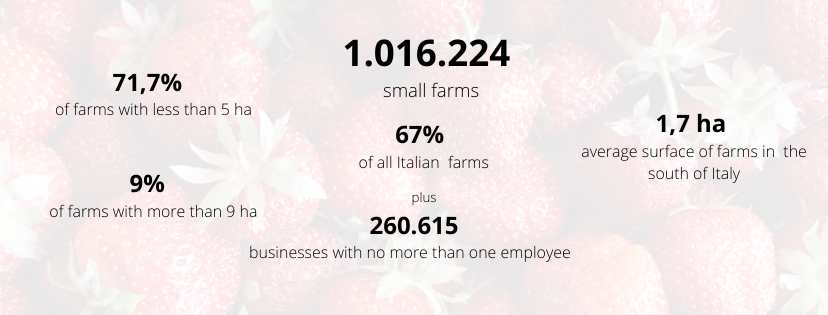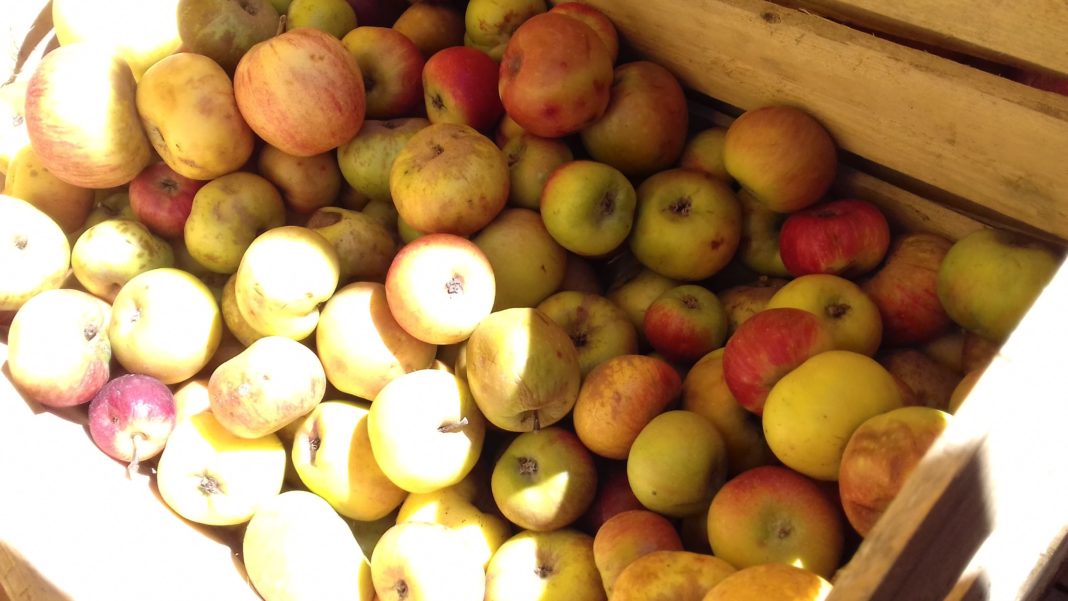A small piece of land, few people to cultivate it; families, mostly. The fruit of every season’s work consumed at home, sold in farmers’ markets, or served in local restaurants. That’s a snapshot of more than a million small and very small farms that dot the Italian countryside, nurturing and preserving the territorial diversity of the nation.
All over the world, the coronavirus pandemic is affecting the production and consumption of food. In Italy the demand is still high; elsewhere, the loss of income of a significant part of the population is already reducing consumers’ capacity to buy food. The shortfall of labour on the fields due to the containment measures is hampering spring harvesting and sowing, while the lockout of farmers’ markets is depriving smallholders of their primary sales channel.
The High Level Panel of Experts of the Committee on World Food Security took the global picture, envisioning the risk of market instability and the adverse impact of a looming food crisis on the most vulnerable.
From the north to the south of Italy, the small farmers who face the COVID-19 emergency generate “a quarter of the national agricultural production”, according to ARI, the Italian Rural Association, an organization of small and family farmers.
The closure of restaurants and of many farmers’ markets has already put smallholders under stress. The reduction in liquidity resulting from limited access to the market — which could be exacerbated by the expected contraction in demand — could lead to a decrease in the production and therefore in the availability of food, according to ARI. “There are farmers who do not sow and do not plant because they are not sure of having a commercial outlet,” Fabrizio Garbarino, president of ARI, told Degrees of Latitude. “There are those who are already throwing away milk because they cannot transform it, because it cannot be preserved,” he added.
Italian peasant agriculture is extremely diversified and it is often, especially in the south, a fundamental support to low incomes. It supplies local markets, solidarity purchase groups, smaller supermarkets and groceries. In short, peasant agriculture is “A slightly more decentralized Italy, which in part was also able to sell some production [in the big cities],” explains Antonio Onorati, ARI coordinator in Lazio. “These farms [have] a characteristic: they have a little breeding, a bit of cereals, a small production of fruit, olive trees…. It is small-scale and diversified agriculture that has now to find solutions, [but which] is not prepared by anything and anyone at the moment.”
Garbarino speaks from personal experience. In addition to his role at ARI, he’s a goat farmer in the Langhe region of Piemonte and producer of cheese in a three-person cooperative with fields and animals. “My farm is living a dramatic moment,” he says. He is also the president of the consortium that protects Robiola di Roccaverano DOP, a seasonally made cheese produced by small family farms and small cooperatives. “It has a very short supply chain … and now the market stagnates completely,” Garabino says.
The south of Italy, where large agricultural enterprises are few in number compared to the north of the country and the family ones rely on an average of 1.7 hectares of land, is, however, of greatest concern. Nino Quaranta is a farmer in Calabria at Laureana di Borrello, in the plain of Gioia Tauro, 10 kilometres from the informal settlement of San Ferdinando, a ghetto where seasonal labourers live in precarious conditions. He cultivates four hectares of land, partly inherited from his parents, partly on loan: Tarocco oranges, now “at the right point”, that Nino wants to donate to the tent city or to those who are in need in town.
He is working his land alone because he has chosen not to put at risk his two employees: one from Nicotera, the other a Senegalese who has been refused his residence permit. “I said to them: Stay at home. If you need anything, tell me,” he told Degrees of Latitude.
According to Quaranta, the lockdown constraints are impairing the production capacity of the small farmers. “It is very difficult to go ahead alone,” he explains. “If you want to plant for the family level — one, two, three people — you can do it, but if you want to plant for more….”
And it’s not simply a matter of planting—there’s everything that goes along with it, from harvesting to value-added production to sales, all of which require manpower. Quaranta uses the example of tomatoes. “If you plant tomatoes, then you must also make the tomato puree. If not, what do you do? Or you have to sell the fresh ones on the market,” he says.
The containment measures are making the work of farmers harder in the rest of Italy as well, starting with getting the first means of production: the fuel. “There’s a bureaucracy to obtain the fuel used in farming, but the technical assistance centres are closed. This is the most banal thing: What do I put in the tractor?” It’s also becoming increasingly challenging for farmers to plan their investments. “Do you plan based on what? … On your usual market if it is partially blocked?” Onorati says.
The card small-scale farmers can play with is diversification: adapting production and relying on the independence from external inputs, thanks to the production and exchange of seeds, animal feeds and fertilizers.
But the knot of liquidity — the money needed to survive until the next harvest, to sow and to carry on the seasonal works — is still unsolved. Market closures have dealt a serious blow to the farmers all over the country.
Accessing the market

Attilio Romagnoli is a peasant from the Veneto region with a farm on the hills of Lake Garda. He presides over six hectares, four of which are vineyards; about an hectare is planted with olive trees, a garden and a little arable land. Then, there’s one hectare of coppice and hedges, an agro-ecological choice to protect the lake’s waters. He mainly produces grapes for the social cellar and before the pandemic he was asking for a loan to transform his produce. “We are in a better situation compared to those in the lower area close to Verona, like the organic producers, those who sell at the market in the city centre,” he explains. “The problem for the small ones is to go and sell our products, which are perishable, seasonal … to be able to reinvest in planting and sowing.”
Peasants have been asking for markets to reopen since the beginning, aware that they won’t be structured the way they were before the emergency any longer. Onorati says that they have prepared a vademecum on the topic to consult. “Security measures are possible; nobody wants to cause harm. Moreover, the farmer runs the highest risk with many customers passing by. No one seems to be considering this issue,” he explains.
In the absence of markets, some farmers are trying door-to-door delivery. It’s a band-aid, according to Garbarino: “If it had been feasible, we would have done it. We need the means of transport and often the farmer has just his private one.”
“We immediately thought of [home delivery],” Romagnoli adds. “[But] we already have a lot to do in the field, then there is the market, the farmhouse. Taking care of everything is difficult for a family. It also leads to the death of the families, because you live to work.” Besides, he lacks the right transportation to make it happen. “I don’t have a farm vehicle. I have a tractor, but I can’t do deliveries with the tractor at a speed of thirty per hour,” he says.
Farmers’ markets are key to ensure liquidity for businesses perennially living on the edge, with reduced margins and often reliant on bank overdrafts. But they are not enough, according to ARI, which is pressing for helping family agriculture access large-scale distribution and for opening new sales channels, including supplying to barracks and hospitals.
“[Farmers] live with the overdraft. They cover it, if they are able, once a year. Then, they immediately redo it. They live with the overdraft until the harvest and until the money from the CAP [the Common agricultural policy of the European Union]; and maybe they draw. Just to start again, two weeks later, with the overdraft,” explains Onorati, who advocates for supporting small farmers that receive less than 20,000 euros from the EU, with the total liquidation of all the European contributions, but also by studying solutions for credit restructuring. “An overdraft of three to five thousand euros is serious for a peasant family, because they are always under pressure. What if you can’t cover it for two years in a row? They’ll come and get your tractor.”
Onorati notes that this lack of liquidity can have unfortunate results, with smaller and more fragile farmers, especially in the south, occasionally falling into the hands of “speculators, Mafia, [and the] illegal economy”.
Seasonal workers, ghosts in the ghettos
Ensuring access to the market is of vital importance, but so is protecting those workers who are the backbone of Italian agriculture: the seasonal labourers. “In this area, with a significant concentration of migrants, it has been [said] for months that they come and steal our jobs. Now that they can’t steal them because of the lockdown, people no longer know what to do because agriculture was mostly supported by them,” Quaranta said.
He elaborates, explaining, “They used to go at the crossroads of the streets looking for work. With the restrictions, they stop working too. There is no longer even illegal work; the problem is really, really serious. An outbreak there, at the San Ferdinando tent city, would be a catastrophe: there are no distances, no security measures, there is nothing.”
The municipality is getting organized to distribute masks, protective equipment and gloves, Quaranta said, but he is worried there will be consequences to the virus with a long-lasting impact. “I am afraid many people will suffer from hunger. If you can’t go to work, what do you do? Starve. You can’t tell them, ‘Stay in the tents for three months.’ They answer, ‘What do we eat?’. It is human; it is right.”
Seventy-five per cent of Italian farms rely on the work of tenants and their families. But seasonally — for the harvest of strawberries, olives, grapes, for instance — workers are needed. There are some Italians, but they are mainly foreigners from Eastern Europe or from the global south. They are now confined in the informal settlements, the most vulnerable to the transmission of the virus, but also to the economic consequences of having lost their livelihoods.
Small farmers are asking the Government for issuing lawful residency permits to those seasonal workers so that they can earn what they need to survive and farmers can sow, plant, and produce food.
According to Onorati, it’s a vital time of year for farmers. “This is the time of the big seasonal works. There is the normal production of greenhouses and the early produce on the field. … You need people. Fresh fruits and vegetables production is poorly mechanized. Then there is the planting: tomatoes, zucchini, peppers, eggplants.… They are planted one by one, millions of seedlings to be put in the field, thousands of hectares; it is a monstrous work. The [small] farmer does it on his own, but those who do specialized [agriculture] and rent the land just for this type of cultivation live on farm seasonal labourers.”
In Veneto the past season was already problematic, Romagnoli says. “Last year in Verona we had early produce — strawberries that were not harvested because of lack of workforce. The asparagus comes up off the land twice a day; if it gets the sun it turns green. Nature goes on and we must be here and there is no workforce,” he said.
What does the future hold? Romagnoli doesn’t know. “We can control just the market where we go with our counter. There, we can shorten the supply chain and decide our fate,” he says. “[But] don’t think of food as if it will always be there, as [if] money is the only thing needed. There is not only money: Without interventions in support of the little ones, there will not only be a shortage of money, there will also be a shortage of food.”
To persevere through the present challenges, peasant farmers now must tap into all the tenacity that cultivating the land has given them. According to Onorati, it’s a resilience that runs deep. He explains, “What [emerges] is the resilience of small farmers. If you see their budgets, people who earn less than 15 thousand euros a year, less than one thousand euros a month, yet they resist, they are there, they have not given up … and this is already a miracle.”



